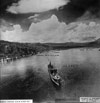|
|
|
|
| Missing In Action (MIA) | Prisoners Of War (POW) | Unexploded Ordnance (UXO) |
| Chronology | Locations | Aircraft | Ships | Submit Info | How You Can Help | Donate |
|
  5th AF Nov 2, 1943  Justin Taylan 2006  Justin Taylan 2006  Justin Taylan 2006  Justin Taylan 2000 |
Location Lat 4° 12' 0S Long 152° 7' 60E Karavia is located on the Gazelle Peninsula at the northeastern tip of New Britain Island. Also spelled Keravia. The original village is known as "Karavia No. 1". The newer village to the south is "Karavia No. 2". Borders Vulcan to the north. Borders Karavia Bay (Keravia Bay) to the east. Beyond to the northeast is Simpson Harbor and Rabaul. Between 1884 until September 1914 part of Deutsch Neu Guinea (German New Guinea). Prewar and during the Pacific War part of the Territory of New Guinea. Today located in East New Britain Province in Papua New Guinea (PNG). Wartime History On January 23, 1942 the Japanese land at Karavia and occupy the area. During the Pacific War, the Japanese built docks, facilities and established camp areas to supporting the anchorage area of Karavia Bay (Keravia Bay). Later in the war, the Japanese dug extensive tunnel systems in the area including a hospital tunnel and barge tunnels. Overlooking the area, guns were emplaced for defense. Allied missions against Keravia June 11, 1943–October 5, 1944 Starting in the middle of June 1943 attacked by Allied bombers and later fighters. During the night of February 18, 1944 five U.S. Navy (USN) destroyers participated in the Battle of Karavia Bay, firing at gun batteries in the Karavia area while at 1:24am, fired torpedoes through the center of the mine field across the entrance to Karavia Bay, in hopes of hitting shipping anchored in the area. Air raids continued by Allied aircraft until the end of the Pacific War. Occupied by the Japanese until September 1945 when Australian forces arrived at Rabaul to accept their surrender. Japanese Hospital Tunnel Located at Karavia No. 1 is an extensive tunnel system dug by Japanese and POW labor, with multiple entrances (some seal by landslides). Inside, are stairs up and down to several levels. The ceilings are well over 6' tall and evidence of tool marks everywhere along the pumice. Inside are alcoves for torch and electric light and the remains of a pulley system, kitchen and quarters. Reportedly, this was an underground hospital. Locals guide visitors through the tunnels for a fee of 5 Kina. Nationalist Chinese Graves Located near the Hospital Tunnel are three graves markers of Nationalist Chinese that died in Rabaul. As of 2006, three grave markers are still present, but have fallen into disrepair in 2006. The three surviving grave markers include (left) Staff Sergeant Tsand You Sang Wong Nam, (center) Captain Nu Kun and (right) Staff Sergeant Kung Hing Cheong. Barge Tunnels (Landing Craft Protection Cave) Seven barge tunnels were carved into the hillside by Japanese using Prisoner Of War (POW) labor to protect landing craft from being targeted by Allied planes. The tunnels were large enough to allow a Daihatsu landing craft to be stored inside. The landing craft could then be moved using a winch on a track to the shore of Karavia Bay (Keravia Bay). One tunnel still has four landing craft inside and has become known as the "barge tunnel" and is a popular tourist and requires paying an entry fee. Daihatsu Landing Craft (Karavia No. 1) The first barge in the tunnel. It is badly rusted, only the stern remains largely intact. The ramp portion is rusted away and is nearly level with the floor. The pilot's wheel is still present. Daihatsu Landing Craft (Karavia No. 2) Second barge in the tunnel. Kanji visible on the pilots armor and #1. After second no more natural light. Better preserved than the first barge. Daihatsu Landing Craft No. 4734 (Karavia No. 3) Third barge in the tunnel. Kanji visible on the pilots armor and 4734 at the base of the shield. Better preserved than the first and second barge. Daihatsu Landing Craft (Karavia No. 4) Fourth barge in the tunnel, furthest inside. Here the ceiling narrows and it is the best preserved, but is in total darkness, and difficult to photograph. Contribute
Information Last Updated
|
Map Fallingrain Karavia 1 Map Fallingrain Karavia 2 |
| Discussion Forum | Daily Updates | Reviews | Museums | Interviews & Oral Histories |
|